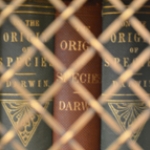At a glance
Special Collections & University Archives
More about us
The department comprises three distinct collecting divisions: Manuscripts, Rare Books, and University Archives; a public services division; and an exhibitions and publications program. Our purpose is to acquire, arrange, describe, preserve, and make available materials of enduring historic value to support the research needs of Stanford students and faculty as well as the larger community of scholars.
Collecting
The holdings of the Department of Special Collections and University Archives comprise more than 260,000 rare, fine press, and artists’ books, and some 59 million pages of unpublished manuscripts and photographs. The department actively acquires materials at a rate of approximately 1,800 linear feet per year.
Archives and manuscript collections include the papers of scientists, mathematicians, technologists, artists, writers, historians, and visionaries; medieval manuscripts; archival photographs; and records of corporations and non-profit organizations with an emphasis on Silicon Valley, California, and Mexican American history.
Notable literary collections include major American authors such John Steinbeck, Robert Creeley, Allen Ginsberg, Gregory Corso, Denise Levertov, Tillie Olson, and William Saroyan. Also represented are important authors whose work represents diverse ethnic and cultural communities, such as Arturo Islas, David Hwang, Cherrie Moraga, Julan Felipe Herrera and Alejandro Morales.
Several collections document the Civil Rights movements of the 1950s to 2000s, including the records of the National Council of La Raza, the Mexican American Legal Defense and Educational Fund, Dr. Huey P. Newton, Inc. and the Black Panther Party, community organizer Fred Ross, Robert and Joseph Starobin, and photographer Bob Fitch, among others.
The Department and the cognizant curators who take the lead in identifying and negotiating acquisition of collections take pride in acquiring materials of noted figures who have shaped our evolving cultural and intellectual landscape. The R. Buckminster Fuller Collection, some 1,451 linear feet of correspondence, manuscripts, architectural plans, models, notes, publications, and miscellany documenting the life of this enigmatic American genius, were acquired in 1999. The Stewart Brand papers and the Whole Earth Catalog Records (1969-1986) also reside at Stanford.
Recent acquisitions of materials by innovators in the arts include the Carolee Schneemann papers, the Lynn Hershman papers, the Hershman interviews with major figures from the feminist art movement that went into the production of !Women, Art, Revolution, and the archive of the noted and still active eco-artists, Helen and Newton Harrison. Stanford also holds the papers of two of the major alternative exhibition spaces of contemporary art, La Mamelle/ArtCom (1975-1995) and New Langton Arts (1975-2009).
Access
We welcome students, scholars and members of the general public to the Field Reading Room. Researchers from beyond the Stanford community make up well over half of our constituency. Whether it is a Columbia University faculty member coming to Stanford to examine the Fuller archive as part of a research project on Bucky’s “World Game,” or a curator visiting from the Budapest Museum of Fine Arts to work in our collection of Gyorgy Kepes papers in preparation for a major Kepes retrospective, the Libraries and its staff provide a welcoming and supportive research environment. Materials are available by prior request for use in the Charles and Frances Field Special Collections reading room in Green Library.
Teaching
Undergraduates are especially welcomed and encouraged to conduct research with these collections. Each year, more than 135 classes are held in Special Collections and University Archives. Stanford instructors are invited to select Special Collections materials for either a general or subject-specific class that enhances the teaching and learning experience for their students.
Exhibitions
Our collections are exhibited by museums and galleries world wide, through the department’s local exhibition program, and via our digital initiatives. The Department of Special Collections presents three primary on-site exhibits in the Peterson Gallery and Munger Rotunda of Green Library per calendar year. The goals of the exhibits program are to:
- enhance the visibility and accessibility of Special Collections and University Archives materials by providing viewers with a scholarly, visually dynamic, and interpretive context in which to consider objects on display;
- inform the university community of recent acquisitions, and reveal resources for teaching and research in Special Collections and the Libraries as a whole;
- encourage working collaborations between the libraries and academic departments, faculty, students, and the broader Stanford community;
- promote collection development through outreach, publicity, and developing relationships with donors and friends of the libraries
Recent major exhibitions in other venues drew heavily on Stanford’s Special Collections and reflect the importance and relevance of documenting the cultural landscape both nationally and internationally:
- Asco: Elite of the Obscure, A Retrospective, 1972–1987. Los Angeles County Museum of Art, Sept. – Dec. 2011; Williams College Museum of Art, Williamstown, Mass., Feb. – July 2012.
- Helios: Eadweard Muybridge in a Time of Change. Corcoran Gallery of Art, Washington, April – July 2010; Tate Britain, London, Sept. 2010 – Jan. 2011; San Francisco Museum of Modern Art, Feb. – June 2011.
- Carleton Watkins: The Art of Perception. San Francisco Museum of Modern Art, May – Sept. 1999; Metropolitan Museum of Art, New York, Oct. 1999 – Jan. 2000.
- Buckminster Fuller: Starting with the Universe. Whitney Museum of American Art, New York, June – Sept. 2008; Museum of Contemporary Art, Chicago, Summer 2009.
- The Art of the Book in California: Five Contemporary Presses. Cantor Arts Center, Stanford, CA 2011.
Preservation
In conjunction with the Division of Preservation and Conservation, we are responsible for safeguarding documents from damage due to improper handling, storage conditions, and properties inherent in the physical documents themselves to ensure that they will remain available for our constituents for as long as is possible.



 Stanford University Home
Stanford University Home